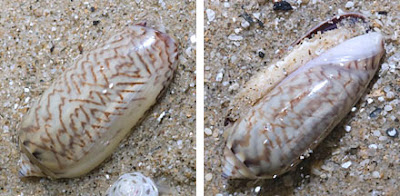This shore was impacted by the massive oil spill nearly a year ago. We were checking it this morning to see how it was doing.
Earlier on, Ivan found another moray eel. It too was rather pale but very much alive. These are the largest Estuarine moray eels (Gymnothorax tile) I've seen!
I took this opportunity to take a photo of their tubular nostrils, a distinctive feature of moray eels.
Here's a photo of the crude oil I saw landing on this stretch of East Coast shore on 26 May. I last visited this shore in July 2010 when the shore was clean, but was a little quiet. But Ivan visited on 22 Apr (facebook) and saw a shore that seemed a little more lively. It was also somewhat lively when I last visited the shore in May 2011.
 One of my favourite animals seen before the oil spill are pretty Button snails (Umbonium vestiarum). As I arrived, I noticed piles of tiny shells of dead Button
snails on the high shore, a promising sign. Elsewhere, there were piles of other kinds of tiny snails.
One of my favourite animals seen before the oil spill are pretty Button snails (Umbonium vestiarum). As I arrived, I noticed piles of tiny shells of dead Button
snails on the high shore, a promising sign. Elsewhere, there were piles of other kinds of tiny snails. I was delighted to come across many live Button snails! I found them the way I used to before the oil spill. When I hit upon a good patch, the snails came up in large numbers in my footsteps on the sand!
It seems I'm not the only one who loves Button snails. I saw something hunting the Button snails! See the big lump moving just under the sand? With the tiny button snails frantically leaping away.
Here's a closer look at the escaping Button snail.
At first I thought the button snails were being hunted by a moon snail. But when I took a closer look, the hunter turned out to be an Olive snail (Family Olividae)! My first time encountering this behaviour in an olive snail. I saw another olive snail nearby. So the return of the button snails probably helped replenish the population of predatory snails too.
I also came across three Ball moon snails (Polinices didyma). These animals can inflate the body to be much larger than the shell. As they plough through the sand, the body also protects the tiny pair of tentacles and little siphon which sticks out above the sand.
Higher up on the shore, I noticed many tiny whelks with their 'faces' jammed into button snail shells. Hopefully, these button snails have died a natural death and the whelks are just cleaning out the shell. Tiny hermit crabs patiently wait nearby, in the hopes of moving into a newly cleaned shell!
The most common whelk I saw today was this one with pretty lilac lines, which I have yet to identify. I finally managed to get better photos of these tiny snails. They seem to have pretty white spots on the foot!
A nice clean shell of the Frog snail (Bufonaria sp.). I rarely see this snail alive. This shell was occupied by a hermit crab.
There were quite a lot of Cake sand dollars (Arachnoides placenta) on the shore. But most were small.
Besides the tiny Tidal hermit crabs (Diogenes sp.) that live in the button snails, there were also some larger Tidal hermit crabs, and several small Striped hermit crabs (Clibanarius infraspinatus).
There were many Moon crabs (Family Matutidae) on the shore from very very tiny ones to medium sized ones.
There were also many Flower crabs (Portunus pelagicus) from those tinier than a Button snail to small ones swimming in the water. On the high shore we saw several burrows and one live Ghost crab (Ocypode cerathophthalmus).
There were also many medium-sized nearly transparent Penaeid shrimps (Family Penaeidae). They were jumping out of the shallow water every now and then.
I didn't see many fishes aside from several tiny Whitings (Family Sillagenidae) in the shallow water. I also came across three gobies (Family Gobiidae) and Ivan saw some tiny flatfishes.
In the sand bar in front of the canal, we saw several small heaps of sand balls made by Sand bubbler crabs (Scopimera sp.). The sand balls were as big as the crab and there were many sand balls. Wow, these crabs sure move a lot of of sand relative to their size.
The seawall was full of life. Here and there, some sponges, and other colourful encrusting life. Also Mermaid's fan seaweed (Padina sp.), Sea lettuce (Ulva sp.) and lower down in the water, on hard surfaces, clumps of Agar-agar seaweed (Gracilaria sp.).
On the seawall, I only saw one Purple climbing crab (Metopograpsus sp.) and two Sally-lightfoot crabs (Grapsus albolineatus). These fast moving crabs are quick to scuttle away. Ivan saw another crab which might have been the Spotted-belly forceps crab (Ozius guttatus).
Looking under the stones, we saw a little fish! Could it be the Cloister blenny (Omobranchus elongatus) that we had seen earlier also at East Coast Park? We carefully put back the stones to avoid squashing animals.
Under the stone, once again I saw these triton snails (Family Ranellidae) laying neat circles of egg masses.
High up on the artificial seawall, I noticed some Javan limpets (Siphonaria javanica) with lots of coils of jelly nearby. Are these their egg masses? Wow, my first time seeing them!
Here's a closer look at the jelly like egg masses.
Even an artificial seawall and sandy shore can be home to a wide variety of animals. It's good to see that this shore is surviving well despite the oil spill last year.
More about the oil spill on this blog and on the Oil spill facebook page.

























